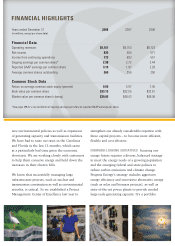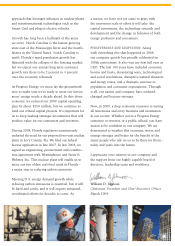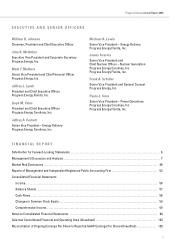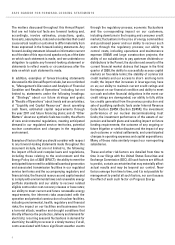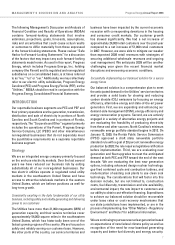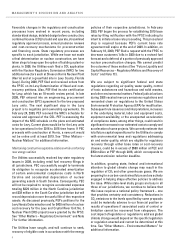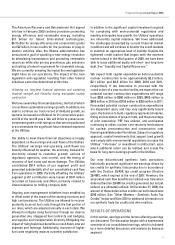Progress Energy 2008 Annual Report Download - page 11
Download and view the complete annual report
Please find page 11 of the 2008 Progress Energy annual report below. You can navigate through the pages in the report by either clicking on the pages listed below, or by using the keyword search tool below to find specific information within the annual report.
Progress Energy Annual Report 2008
9
The American Recovery and Reinvestment Act signed
into law in February 2009 contains provisions promoting
energy efficiency and renewable energy, including
$11 billion for Smart Grid-related technologies,
$6.3 billion for energy-efficiency and conservation grants
and $2 billion in tax credits for the purchase of plug-in
electric vehicles. Also, the Obama administration has
announced a goal of sparking a new energy revolution
by stimulating transmission and promoting renewable
resources while also pricing greenhouse gas emissions
and setting a federal requirement for renewable energy.
We are currently reviewing the impact the new legislation
might have on our operations. The impact of the new
legislation and regulation resulting from other federal
initiatives cannot be determined at this time.
Achieving our long-term financial objectives and sustaining
financial strength and flexibility during anticipated nuclear
construction
We have several key financial objectives, the first of which
is to achieve sustainable earnings growth. In addition, we
seek to continue our track record of dividend growth, as
we have increased our dividend for 21 consecutive years,
and 33 of the last 34 years. We will strive to preserve our
investment grade credit ratings so that we are positioned
to accommodate the significant future demand expected
at the Utilities.
Our ability to meet these financial objectives is largely
dependent on the earnings and cash flows of the Utilities.
The Utilities’ earnings and operating cash flows are
heavily influenced by weather, the economy, demand for
electricity related to customer growth, actions of
regulatory agencies, cost control, and the timing of
recovery of fuel costs and storm damage. The Utilities
contributed $914 million of our segment profit and
generated substantially all of our consolidated cash flow
from operations in 2008. Partially offsetting the Utilities’
segment profit contribution were losses of $141 million
recorded at Corporate and Other, primarily related to
interest expense on holding company debt.
Ongoing cost management initiatives have enabled us
to offset some of the impact of the slowing economy and
high cost pressures. The Utilities are allowed to recover
prudently incurred fuel costs through the fuel portion of
our rates, which are adjusted annually in each state. We
attempt to mitigate rising fuel prices through our diverse
generation mix, staggered fuel contracts and hedging,
and supplier and transportation diversity. Mitigating the
impact of rising fuel prices benefits our cash flows, interest
expense and leverage. Additionally, recovery of higher
fuel costs negatively impacts customer satisfaction.
In addition to the significant capital investment required
for complying with environmental regulations and
meeting anticipated load growth, the Utilities’ operations
are inherently capital intensive. We have addressed
the challenges presented by current financial market
conditions and will continue to monitor the credit markets
to maintain an appropriate level of liquidity. Despite the
tightened credit market that began with the extreme
market turmoil in the third quarter of 2008, we have been
able to issue additional equity and short- and long-term
debt. See “Liquidity and Capital Resources.”
We expect total capital expenditures before potential
nuclear construction to be approximately $2.2 billion,
$2.1 billion and $2.0 billion for 2009, 2010 and 2011,
respectively. If we determine to proceed with the
construction of a new nuclear facility, we expect that our
potential nuclear construction expenditures will range
from $260 million to $560 million in 2009, $460 million to
$660 million in 2010 and $750 million to $950 million in 2011.
Forecasted potential nuclear construction expenditures
are dependent upon, and may vary significantly based
upon, the decision to build, regulatory approval schedules,
timing and escalation of project costs, and the percentage
of joint ownership. PEF has utilized, and anticipates
continuing to utilize, nuclear cost-recovery mechanisms
for nuclear preconstruction and construction cost
financing available under Florida law. Subject to regulatory
approval, capital investments that support load growth
and comply with environmental regulations increase the
Utilities’ “rate base” or investment in utility plant, upon
which additional return can be realized, and create the
basis for long-term earnings growth in the Utilities.
Our now discontinued synthetic fuels operations
historically produced significant net earnings driven by
tax credits for synthetic fuels production in accordance
with the Section 29/45K tax credit program (Section
29/45K), which expired at the end of 2007. However, the
associated cash flow benefits are realized over time when
deferred Section 29/45K tax credits generated, but not yet
utilized, are ultimately utilized. At December 31, 2008, the
amount of these deferred tax credits carried forward was
$799 million. See “Other Matters – Synthetic Fuels Tax
Credits” below and Note 22D for additional information on
our synthetic fuels tax credits and other matters.
RESULTS OF OPERATIONS
In this section, earnings and the factors affecting earnings
are discussed. The discussion begins with a summarized
overview of our consolidated earnings, which is followed
by a more detailed discussion and analysis by business
segment.





